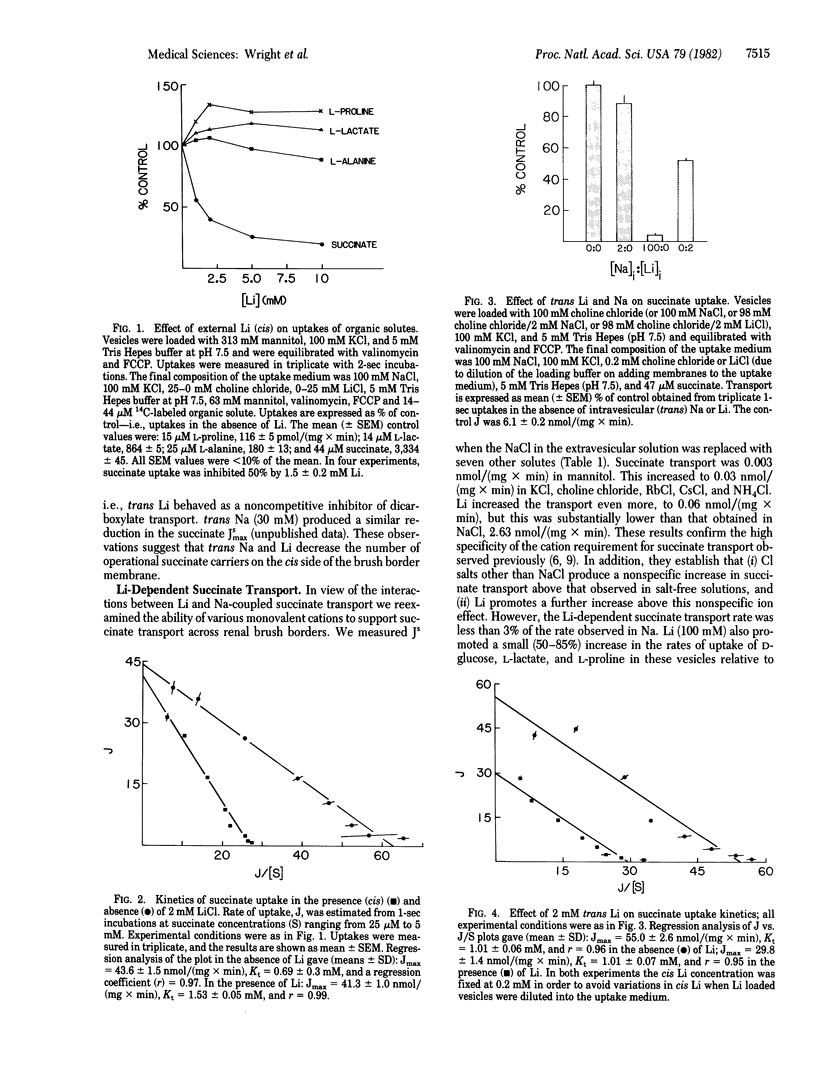Abstract
The effect of lithium on the renal transport of Krebs cycle intermediates was studied in brush border membrane vesicles isolated from the rabbit renal cortex. The di- and tricarboxylic acids are avidly transported across renal brush border membranes by a sodium cotransport system. Lithium acted as a potent, specific, competitive inhibitor (Ki = 1.2 mM) of succinate/sodium cotransport when added to the uptake medium. Similar effects were observed for citrate but not D-glucose, L-phenylalanine, L-proline, L-alanine, or L-lactate transport. Intravesicular lithium behaved as a noncompetitive inhibitor of succinate transport in the absence of sodium. These results account for the observation that therapeutic doses of lithium increase the renal excretion of Krebs cycle intermediates. The existence of a transport system for alpha-ketoglutarate in synaptosomes suggests a possible target for lithium in the central nervous system.
Full text
PDF



Images in this article
Selected References
These references are in PubMed. This may not be the complete list of references from this article.
- Bond P. A., Jenner F. A., Lee C. R., Lenton E., Pollitt R. J., Sampson G. A. The effect of lithium salts on the urinary excretion of -oxoglutarate in man. Br J Pharmacol. 1972 Sep;46(1):116–123. doi: 10.1111/j.1476-5381.1972.tb06854.x. [DOI] [PMC free article] [PubMed] [Google Scholar]
- Bond P. A., Jenner F. A. The effect of lithium and related metal ions on the urinary excretion of 2-oxoglutarate and citrate in the rat. Br J Pharmacol. 1974 Feb;50(2):283–289. doi: 10.1111/j.1476-5381.1974.tb08574.x. [DOI] [PMC free article] [PubMed] [Google Scholar]
- Ehrlich B. E., Diamond J. M. Lithium, membranes, and manic-depressive illness. J Membr Biol. 1980;52(3):187–200. doi: 10.1007/BF01869189. [DOI] [PubMed] [Google Scholar]
- Kippen I., Hirayama B., Klinenberg J. R., Wright E. M. Transport of tricarboxylic acid cycle intermediates by membrane vesicles from renal brush border. Proc Natl Acad Sci U S A. 1979 Jul;76(7):3397–3400. doi: 10.1073/pnas.76.7.3397. [DOI] [PMC free article] [PubMed] [Google Scholar]
- Shank R. P., Campbell G. L. Glutamine and alpha-ketoglutarate uptake and metabolism by nerve terminal enriched material from mouse cerebellum. Neurochem Res. 1982 May;7(5):601–616. doi: 10.1007/BF00965126. [DOI] [PubMed] [Google Scholar]
- Wright S. H., Kippen I., Klinenberg J. R., Wright E. M. Specificity of the transport system for tricarboxylic acid cycle intermediates in renal brush borders. J Membr Biol. 1980 Nov 15;57(1):73–82. doi: 10.1007/BF01868987. [DOI] [PubMed] [Google Scholar]
- Wright S. H., Kippen I., Wright E. M. Effect of pH on the transport of Krebs cycle intermediates in renal brush border membranes. Biochim Biophys Acta. 1982 Jan 22;684(2):287–290. doi: 10.1016/0005-2736(82)90019-0. [DOI] [PubMed] [Google Scholar]
- Wright S. H., Kippen I., Wright E. M. Stoichiometry of Na+-succinate cotransport in renal brush-border membranes. J Biol Chem. 1982 Feb 25;257(4):1773–1778. [PubMed] [Google Scholar]
- Wright S. H., Krasne S., Kippen I., Wright E. M. Na+-dependent transport of tricarboxylic acid cycle intermediates by renal brush border membranes. Effects on fluorescence of a potential-sensitive cyanine dye. Biochim Biophys Acta. 1981 Feb 6;640(3):767–778. doi: 10.1016/0005-2736(81)90107-3. [DOI] [PubMed] [Google Scholar]



